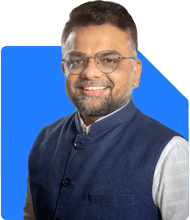Ramalingam Kalirajan |10878 Answers |Ask -Follow
Mutual Funds, Financial Planning Expert - Answered on Apr 25, 2025
He has an MBA in finance from the University of Madras and is a certified financial planner.
He is the director and chief financial planner at Holistic Investment, a Chennai-based firm that offers financial planning and wealth management advice.... more

I will invest 6k per month please suggest some safe plan
Now let us look at how to use this Rs 6,000 monthly in a smart and safe way.
Let me give you a full and simple 360-degree plan.
We will talk about:
What does safe investing mean?
Where to invest Rs 6,000 monthly?
How to keep your money protected?
How to grow your money slowly and steadily?
What risks to avoid?
What not to do?
What you can expect in return?
What you should track and how?
Let us begin step by step.
Understanding What "Safe Investment" Means
There is no investment that is 100% risk-free.
Even bank fixed deposits have some risk. Not all banks are safe.
But we can choose options that are more stable and time-tested.
Safe does not mean no return. But safe usually means moderate return.
You will not get very high returns. But you will also avoid big losses.
When you invest regularly, even small growth becomes big in long term.
So safety and patience work together for success.
Setting a Goal for Your Rs 6,000 Per Month
What is your goal for this Rs 6,000? Is it for retirement?
Is it for child’s education? Or for a future home? Or for monthly income later?
Knowing the goal helps you choose the right investment path.
If your goal is more than 5 years away, you can take slightly more risk.
If your goal is less than 3 years away, you must stay very safe.
Please fix your goal first. That is the starting point.
Best Way to Invest Rs 6,000 Monthly – Step-by-Step Plan
Let me now share a safe and step-wise plan.
Emergency Corpus First
Do you already have 6 months of expenses saved?
If not, keep Rs 6,000 in a bank recurring deposit.
Or use a liquid mutual fund with good safety record.
Build an emergency fund of at least Rs 50,000–Rs 1,00,000.
Only after this, start regular mutual fund investing.
Choose a Regular Plan of Mutual Fund
Please do not choose direct plans of mutual funds.
Direct plans may look cheap. But they do not give personal service.
A Certified Financial Planner can help through regular plans.
Direct plans are like driving without a GPS.
Regular plans give better tracking, support and timely advice.
Avoid Index Funds for Safety
Index funds copy the market. They are not managed actively.
In a bad market, they fall badly. No one protects you.
In actively managed funds, the fund manager reduces risk.
You need active management when you want safety.
So always choose actively managed mutual funds.
Choose Funds Based on Goal Period
If your goal is within 3 years, choose short-duration debt mutual funds.
If your goal is 5–7 years away, use hybrid funds or conservative balanced funds.
If your goal is 7+ years away, use equity mutual funds in small amount.
Your Rs 6,000 can be split as per time.
Suggested Asset Allocation for Rs 6,000 Monthly (General Model)
Assuming long-term goal (5+ years), you can follow:
Rs 3,000 – Conservative Hybrid Mutual Fund
Rs 2,000 – Equity Mutual Fund (Large and Mid-Cap)
Rs 1,000 – Liquid Fund or Short-Term Debt Fund
This mix gives safety, moderate growth, and steady liquidity.
How to Monitor Your Investment
Check once every 6 months. Do not check every week.
Look at performance compared to a fixed deposit.
Your funds should beat FD by 2% or more.
If any fund gives low return for 3 years, change it.
Take help from a Certified Financial Planner.
Use only regular plans through a good MFD and CFP.
Mutual Fund Tax Rules You Must Know
Equity mutual fund returns held for over 1 year are called long term.
Gains above Rs 1.25 lakh yearly are taxed at 12.5%.
Gains below Rs 1.25 lakh yearly are tax-free.
Debt mutual fund returns are taxed as per your income tax slab.
You can use tax-saving mutual funds if needed.
What You Should Not Do
Do not keep all Rs 6,000 in a bank FD. Inflation will eat your returns.
Do not go for chit funds or ponzi schemes. They look safe but are risky.
Do not buy any investment product from insurance agents.
Do not fall for ULIPs or investment cum insurance plans.
Do not stop SIP when market goes down. That is when you get more benefit.
Do not chase the highest return funds. Focus on stable and consistent ones.
Why Safety Does Not Mean Zero Equity
Some equity exposure is good even if you want safety.
Without equity, your money will not beat inflation.
But choose only large and mid-cap equity funds.
And keep percentage low, like 25%-35% of Rs 6,000.
Rebalance every year. Keep your original ratio same.
If You Already Have Insurance or ULIP
If you hold LIC endowment, money-back or ULIP policies, stop future premiums.
Surrender them if lock-in is over and you will get fair value.
Reinvest the maturity or surrender amount in mutual funds.
Keep insurance and investment separate always.
How a CFP Can Help You
A Certified Financial Planner is trained to guide you step by step.
They will not just sell. They plan your whole money journey.
They help in fund selection, monitoring, withdrawal planning, and rebalancing.
They also help in taxes and documentation.
You will not be alone in the process.
What Can You Expect from Rs 6,000 Monthly?
You can create Rs 10 lakh to Rs 15 lakh in 10 to 15 years.
This depends on fund selection and market movement.
But this is possible with patience and discipline.
Start now and stay regular. Do not skip SIP.
What to Do if Goal Changes Midway?
Suppose you need money early. You can stop SIP.
You can start SWP (Systematic Withdrawal Plan) after 3 years.
You can move money to safer funds when you reach the goal.
A CFP can guide how to change funds without big tax impact.
Safe Exit Plan Later
Do not withdraw full amount at once.
Start a SWP after your goal period.
You can take Rs 3,000 to Rs 5,000 monthly from corpus.
This gives income and keeps capital partly invested.
It is better than FD interest.
Finally
Investing Rs 6,000 per month can create big wealth.
Do it in regular mutual funds with active management.
Keep goal clear. Start small. Stay patient.
Do not chase hot tips or risky schemes.
Choose safety first. Add growth slowly.
Review every year with a Certified Financial Planner.
Always keep emergency fund separate.
If you follow this path, your future will be safer and stronger.
Money grows slowly but surely with regular SIP.
Take the first step today. Your future self will thank you.
Best Regards,
K. Ramalingam, MBA, CFP,
Chief Financial Planner,
www.holisticinvestment.in
https://www.youtube.com/@HolisticInvestment
You may like to see similar questions and answers below
Vivek Shah | Answer |Ask -Follow
Financial Planner - Answered on Jun 19, 2023
Ramalingam Kalirajan |10878 Answers |Ask -Follow
Mutual Funds, Financial Planning Expert - Answered on Apr 12, 2024
Ramalingam Kalirajan |10878 Answers |Ask -Follow
Mutual Funds, Financial Planning Expert - Answered on May 18, 2024
Samraat Jadhav |2503 Answers |Ask -Follow
Stock Market Expert - Answered on May 07, 2024
Ramalingam Kalirajan |10878 Answers |Ask -Follow
Mutual Funds, Financial Planning Expert - Answered on Sep 08, 2025
Dr Nagarajan J S K |2577 Answers |Ask -Follow
NEET, Medical, Pharmacy Careers - Answered on Dec 10, 2025
Mayank Chandel |2570 Answers |Ask -Follow
IIT-JEE, NEET-UG, SAT, CLAT, CA, CS Exam Expert - Answered on Dec 10, 2025
Samraat Jadhav |2503 Answers |Ask -Follow
Stock Market Expert - Answered on Dec 10, 2025
Radheshyam Zanwar |6741 Answers |Ask -Follow
MHT-CET, IIT-JEE, NEET-UG Expert - Answered on Dec 10, 2025
Ramalingam Kalirajan |10878 Answers |Ask -Follow
Mutual Funds, Financial Planning Expert - Answered on Dec 10, 2025
Ramalingam Kalirajan |10878 Answers |Ask -Follow
Mutual Funds, Financial Planning Expert - Answered on Dec 10, 2025
Samraat Jadhav |2503 Answers |Ask -Follow
Stock Market Expert - Answered on Dec 10, 2025
Samraat Jadhav |2503 Answers |Ask -Follow
Stock Market Expert - Answered on Dec 10, 2025
Samraat Jadhav |2503 Answers |Ask -Follow
Stock Market Expert - Answered on Dec 10, 2025
Shalini Singh |180 Answers |Ask -Follow
Dating Coach - Answered on Dec 10, 2025




























